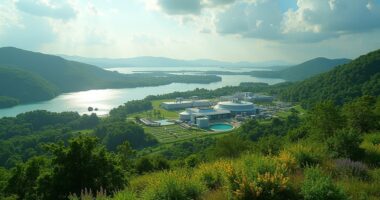Canada is stewing a pot full of eco-friendly initiatives aimed at transforming cities by 2025. Think urban greening with native trees and mini forests to boost biodiversity, along with active transport networks—biking and walking paths galore! Nature-based solutions like green roofs tackle climate challenges while providing their own set of perks. Toss in collaborations with Indigenous communities, and you’ve got a recipe for cooler, cleaner cities. Stick around, and you’ll discover even more sustainable secrets brewing in these urban landscapes!
Quick Overview
- Urban greening initiatives aim to plant 3 million trees by 2030, focusing on native species for improved ecosystem health and community involvement.
- Biodiversity projects, including pollinator gardens and de-paving efforts, create resilient urban habitats and enhance social impacts in community planning.
- Active transportation infrastructure expansion includes multi-use paths and protected lanes, promoting biking and walking to reduce carbon emissions in urban areas.
- Nature-based solutions, like wetland restoration and green roofs, provide cost-effective climate strategies, improving air quality and managing stormwater effectively.
- Collaborations with Indigenous communities drive sustainable development, integrating traditional knowledge to enhance urban green spaces and quality of life.
Urban Greening Initiatives for Biodiversity Restoration
Urban greening initiatives in Canadian cities are transforming concrete jungles into vibrant ecosystems, and the excitement is palpable.
With over 2.4 million trees planted, these programs are on track to reach 3 million by 2030, all while prioritizing native species.
Community participation fosters a sense of stewardship, ensuring long-term health for local ecosystems.
Projects like mini forests use the Miyawaki method, packing diverse plant life into small spaces, making urban areas feel like nature’s playground.
From pollinator gardens to de-paving efforts, these initiatives are not just about trees; they’re about creating resilient habitats that invite everyone to enjoy nature’s splendor. Additionally, these projects emphasize urban communities and their social impacts, highlighting the importance of biodiversity in urban planning. Furthermore, through the CN EcoConnexions program, a total of 500,000 dollars has been allocated to support these greening efforts across various Canadian communities. These initiatives align with broader goals of green infrastructure development, creating interconnected systems that manage stormwater, reduce urban heat islands, and improve overall quality of life.
Enhancing Mobility Through Active Transportation Networks
As cities across Canada aim to become more livable and sustainable, enhancing mobility through active transportation networks has emerged as a key strategy, not just for getting from point A to B, but for reimagining urban life altogether.
With nearly 25% of Canada’s bikeways built recently, cities are investing in multi-use paths, protected lanes, and enhanced sidewalks. This infrastructure not only promotes biking and walking but also connects communities, making short commutes safer and more enjoyable. These developments represent a crucial shift toward eco-friendly transportation solutions that reduce carbon emissions while improving quality of life. In fact, urban transit trips totaled 133.7 million in May, illustrating the growing demand for sustainable transportation options. As a part of this push, the Canada Public Transit Fund is allocating $30 billion over 10 years to expand access to public transit. Imagine a world where kids bike to school without worry—active transportation is paving the way, one bike lane at a time, for healthier, happier urban living.
Implementing Nature-Based Solutions for Climate Action
In the quest for climate action, nature-based solutions are not just a trendy buzzword; they’re the eco-friendly superheroes cities have been waiting for.
With a $3.16 billion investment to plant two billion trees, urban forests will not only enhance air quality but also cool down cities like a giant leafy umbrella. Natural climate solutions could reduce Canada’s emissions by 78Mt annually by 2030, which highlights their critical role in combating climate change. Additionally, as house prices in cities continue to rise, investing in natural spaces becomes even more essential for sustainable urban development.
A $3.16 billion investment to plant two billion trees will transform cities into cooler, cleaner, and greener havens.
Meanwhile, wetland restoration is like giving nature a much-needed spa day, improving biodiversity and carbon storage. These ecosystem services provide cost-effective alternatives to traditional infrastructure while simultaneously addressing multiple environmental challenges.
Green roofs and parks are the superheroes of stormwater management, too!
As municipalities embrace these strategies, collaboration with Indigenous communities guarantees we blend knowledge and action for a sustainable future—talk about a power team!









